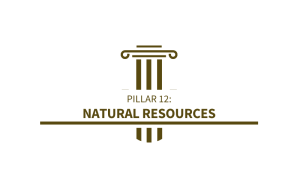
Key Indicators:
Number of World Heritage natural sites, Total known species, Total protected areas, Natural tourism Digital Demand, Number of terrestrial and freshwater ecoregions
Note: This pillar measures the available natural capital as well as the development of outdoor tourism activities. Natural capital is defined in terms of landscape, natural parks, and the richness of the fauna. To an extent, this pillar captures how natural resources are promoted rather than the actual existing natural heritage of a country.
The Natural Resources pillar for Pakistan, as outlined by the World Economic Forum, provides insight into the state of the country’s natural assets and their utilization. According to the T&T Development Index Report 2024, Pakistan is ranked 51 out of 119 countries, showing improvement with a score of 2.89,[144] reflecting a positive trend in the preservation and management of its natural resources.
The indicator Number of World Heritage natural sites show an increase in ranking to 85, although the value remains unchanged, resulting in a score of 1.00, as there are no World Heritage natural sites in Pakistan.[145]
Pakistan’s Total known species, while ranking 52, showcases growth to 2,860.00, with a corresponding increase in score to 2.29, signifying biodiversity preservation efforts. However, there’s a concerning decrease in the Total protected areas, with Pakistan ranked 42, and a significant decline to 99,995.50 square kilometers, resulting in a lowered score of 5.00, suggesting the need for strengthened conservation measures.
As of 2022, terrestrial protected areas in Pakistan cover 12.31% of the total land area,[146] up from 12% before 2018, with plans to expand to 13 to 15% by 2023.[147] The country boasts 21 National Parks covering about 29,589 km², approximately 3% of Pakistan’s total land area,[148] 94 Wildlife Sanctuaries, 7 Private Reserves, 99 Game Reserves, and 9 other Protected Areas.[149]
Natural tourism digital demand presents a challenge, with Pakistan ranking 76 and experiencing a decrease in score to 1.39, necessitating enhanced digital marketing strategies to promote natural attractions. Finally, the Number of terrestrial and freshwater ecoregions ranks 18, though the value remains steady at 25.00, resulting in a score of 4.75, showcasing the country’s diverse ecological landscapes. Two terrestrial ecosystems in Pakistan are listed among the Global 200 priority ecosystems of the Millennium Ecosystem Assessment.[150]
The Global 200 Analysis identifies five eco-regions in Pakistan, with the Indus Ecoregion being the only one that lies fully within the country.[151] Noted as one of the 40 most biologically rich ecoregions, it spans about 65% of Sindh and parts of Balochistan, featuring riverine, mangrove, and desert ecosystems.[152] WWF-P is focusing conservation efforts here, with plans to expand to other ecoregions based on the successes of the Indus Ecoregion Program.
Pakistan can leverage its natural landscapes to enhance outdoor recreation and nature-based tourism, which improves health, fosters social connections, and generates revenue for conservation.[153] Promoting its scenic areas can stimulate local economies, create jobs, and advance conservation efforts.
The data collectively underscores the importance of sustainable management practices to safeguard Pakistan’s natural resources for future generations while leveraging them for economic and tourism development.
Eco-tourism in Pakistan harnesses the country’s natural resources, offering travelers sustainable activities like hiking and wildlife spotting while benefiting local communities through job creation, cultural preservation, and community development. Involving locals in planning and emphasizing sustainability fosters cultural exchange and supports both conservation and economic growth.[154]
